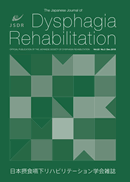Volume 22, Issue 3
The Japanese Journal of Dysphagia Rehabilitation
Displaying 1-10 of 10 articles from this issue
- |<
- <
- 1
- >
- >|
Original Paper
-
2018Volume 22Issue 3 Pages 185-192
Published: December 31, 2018
Released on J-STAGE: April 30, 2019
Download PDF (382K) -
2018Volume 22Issue 3 Pages 193-204
Published: December 31, 2018
Released on J-STAGE: April 30, 2019
Download PDF (737K) -
2018Volume 22Issue 3 Pages 205-213
Published: December 31, 2018
Released on J-STAGE: April 30, 2019
Download PDF (545K) -
2018Volume 22Issue 3 Pages 214-224
Published: December 31, 2018
Released on J-STAGE: April 30, 2019
Download PDF (477K) -
2018Volume 22Issue 3 Pages 225-236
Published: December 31, 2018
Released on J-STAGE: April 30, 2019
Download PDF (491K) -
2018Volume 22Issue 3 Pages 237-248
Published: December 31, 2018
Released on J-STAGE: April 30, 2019
Download PDF (1103K) -
2018Volume 22Issue 3 Pages 249-259
Published: December 31, 2018
Released on J-STAGE: April 30, 2019
Download PDF (543K)
Short Communication
-
2018Volume 22Issue 3 Pages 260-266
Published: December 31, 2018
Released on J-STAGE: April 30, 2019
Download PDF (595K)
Case Report
-
2018Volume 22Issue 3 Pages 267-272
Published: December 31, 2018
Released on J-STAGE: April 30, 2019
Download PDF (478K)
Clinical Hint
-
2018Volume 22Issue 3 Pages 273-277
Published: December 31, 2018
Released on J-STAGE: April 30, 2019
Download PDF (310K)
- |<
- <
- 1
- >
- >|
